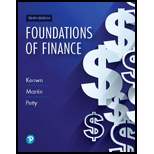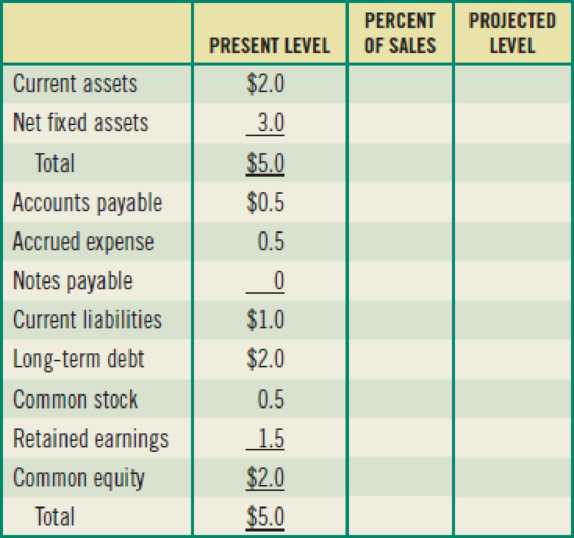
Concept explainers
(Financial forecasting—discretionary financing needs) The most recent
Armadillo Dog Biscuit Co. Inc., ($ Millions)

The firm’s net profits were 6 percent of the current year’s sales but are expected to rise to 7 percent of next year’s sales. To help support its anticipated growth in asset needs next year, the firm has suspended plans to pay cash dividends to its stockholders. In past years a $1.50-per-share dividend has been paid annually. Armadillo’s accounts payable and accrued expenses are expected to vary directly with sales. In addition, notes payable will be used to supply the funds needed to finance next year’s operations that are not forthcoming from other sources.
- a. Fill in the table and project the firm’s needs for discretionary financing. Use notes payable as the balancing entry for future discretionary financing needs.
- b. Compare Armadillo’s current ratio (current assets/current liabilities) and debt ratio (total liabilities/total assets) before the growth in sales and after. What was the effect of the expanded sales on these two dimensions of Armadillo’s financial condition?
- c. What difference, if any, would have resulted if Armadillo’s sales had risen to $6 million in 1 year and $7 million only after 2 years? Discuss only; no calculations are required.
Want to see the full answer?
Check out a sample textbook solution
Chapter 14 Solutions
Foundations Of Finance
- Delta Company, a U.S. MNC, is contemplating making a foreign capital expenditure in South Africa. The initial cost of the project is ZAR11,000. The annual cash flows over the five-year economic life of the project in ZAR are estimated to be 3,300, 4,300, 5,290, 6,280, and 7,250. The parent firm's cost of capital in dollars is 9,5 percent. Long-run inflation is forecasted to be 3 percent per annum in the United States and 7 percent in South Africa. The current spot foreign exchange rate is ZAR per USD = 3.75. Required:. Calculating the NPV in ZAR using the ZAR equivalent cost of capital according to the Fisher effect and then converting to USD at the current spot rate. - NPV in USD using fisher effect Converting all cash flows from ZAR to USD at purchasing power parity forecasted exchange rates and then calculating the NPV at the dollar cost of capital. - NPV in USD using PPP rates Are the two USD NPs different or the same? What is the NPV in dollars if the actual pattern of ZAR per…arrow_forwardWhat is the 50/30/20 budgeting rule in finance?arrow_forwardHow do student loans impact long-term financial health?arrow_forward
- With regard to foreign currency translation methods used by foreign MNCs, Multiple Choice a. foreign currency translation methods are generally only used by U.S. based MNCs since foreign firms have a built-in hedge by being foreign. b. are generally the same methods used by U.S.-based firms. c. are exactly the same methods used by U.S.-based firms since GAAP is GAAP. d. none of the options.arrow_forwardCray Research sold a supercomputer to the Max Planck Institute in Germany on credit and invoiced €11.60 million payable in six months. Currently, the six-month forward exchange rate is $1.18 per euro and the foreign exchange adviser for Cray Research predicts that the spot rate is likely to be $113 per euro in six months.Required: a. What is the expected gain/loss from a forward hedge?Note: A Negative value should be indicated with a minus sign. Do not round intermediate calculations. Round your final answer in whole dollars not in millions.arrow_forwardWhat is the time value of money and how is it calculated? need answer!arrow_forward
 EBK CONTEMPORARY FINANCIAL MANAGEMENTFinanceISBN:9781337514835Author:MOYERPublisher:CENGAGE LEARNING - CONSIGNMENTPrinciples of Accounting Volume 2AccountingISBN:9781947172609Author:OpenStaxPublisher:OpenStax College
EBK CONTEMPORARY FINANCIAL MANAGEMENTFinanceISBN:9781337514835Author:MOYERPublisher:CENGAGE LEARNING - CONSIGNMENTPrinciples of Accounting Volume 2AccountingISBN:9781947172609Author:OpenStaxPublisher:OpenStax College

